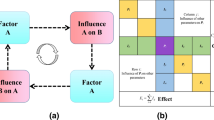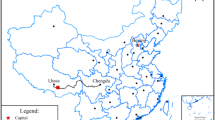Abstract
To investigate surrounding rock quality (SRQ) of the tunnels subjected to design and construction processes, this research employed a weighted norms based fuzzy comprehensive evaluation (WN-FCE) method by integrating weighted norms based grey relational analysis and fuzzy mathematics theory. Furthermore, this study established a membership function between each of evaluating indexes and the grade of surrounding rocks to obtain evaluated matrix of a single factor, and derived the weights of each of the indexes by introducing weighted norms based grey relation. On these bases, the fuzzy sets could be obtained based on the WN-FCE approach and it was further used for the evaluation of SRQ of tunnels. The saturated uniaxial compressive strength Rc of rocks, RQD value of SRQ index, friction coefficient Jf of structural planes, joint spacing Jd, groundwater state W, and intactness index Kv of rock masses were used as the evaluating indexes to comprehensively evaluate the SRQ. The evaluation results were in agreement with those obtained by using the evaluation method based on extension theory and the root-mean-square residual (RMR) method. This indicates that the WN-FCE method is able to accurately reflect the grade of surrounding rocks of tunnels.

Similar content being viewed by others
Data availability
Enquiries about data availability should be directed to the authors.
References
Alemdag S, Gurocak Z, Cevik A, Cabalar AF, Gokceoglu C (2016) Modeling deformation modulus of a stratified sedimentary rock mass using neural network, fuzzy inference and genetic programming. Eng Geol 203:70–82
Aydan Ö, Ulusay R, Tokashiki N (2014) A new rock mass quality rating system: rock mass quality rating (RMQR) and its application to the estimation of geomechanical characteristics of rock masses. Rock Mech Rock Eng 47(4):1255–1276
Barton N, Lien R, Lunde J (1974) Engineering classification of rock masses for the design of tunnel support. Rock Mech 6(4):189–236
Bieniawski ZT (1978) Determining rock mass deformability: experience from case histories. Int J Rock Mech Min Sci Geomech Abstr 15(5):237–247
Gokceoglu C, Yesilnacar E, Sonmez H, Kayabasi A (2004) A neuro-fuzzy model for modulus of deformation of jointed rock masses. Comput Geotech 31(5):375–383
Harrison JP, Hudson JA (2010) Incorporating parameter variability in rock mechanics analyses: fuzzy mathematics applied to underground rock spalling. Rock Mech Rock Eng 43(2):219–224
Huang RD, Zhao ZF, Li P, Zhang XJ (2012) Based on entropy weight method and extenics tunnel’s quality evaluation of surrounding rock. Highw Eng 37(1):139–143
Jalalifar H, Mojedifar S, Sahebi AA, Nezamabadi PH (2011) Application of the adaptive neuro-fuzzy inference system for prediction of a rock engineering classification system. Comput Geotech 38(6):783–790
Javanmardi E, Liu S, Xie N (2020) Exploring the philosophical paradigm of grey systems theory as a postmodern theory. Found Sci 25(4):905–925
Marinos V (2019) A revised, geotechnical classification GSI system for tectonically disturbed heterogeneous rock masses, such as flysch. Bull Eng Geol Environ 78(2):899–912
Salimi A, Rostami J, Moormann C (2017) Evaluating the suitability of existing rock mass classification systems for TBM performance prediction by using a regression tree. Procedia Eng 191:299–309
Su YH, He MC, Sun XM (2007) Equivalent characteristic of membership function type in rock mass fuzzy classification. J Univ Sci Technol Beijing 29(7):670–675
Tyrrell GW (1914) A review of igneous rock classification. Sci Prog Twent Century 9(33):60–84
Wu Y, Zhou F, Kong J (2020) Innovative design approach for product design based on TRIZ, AD, fuzzy and Grey relational analysis. Comput Ind Eng 140:106276
Zhang Y, Zhang X (2007) Grey correlation analysis between strength of slag cement and particle fractions of slag powder. Cement Concr Compos 29(6):498–504
Funding
The authors have not disclosed any funding.
Author information
Authors and Affiliations
Corresponding author
Ethics declarations
Competing Interests
The authors have not disclosed any competing interests.
Additional information
Publisher's Note
Springer Nature remains neutral with regard to jurisdictional claims in published maps and institutional affiliations.
Rights and permissions
Springer Nature or its licensor holds exclusive rights to this article under a publishing agreement with the author(s) or other rightsholder(s); author self-archiving of the accepted manuscript version of this article is solely governed by the terms of such publishing agreement and applicable law.
About this article
Cite this article
Zhao, H., Zhang, J., Liang, S. et al. Evaluation of Surrounding Rock Quality of Tunnels Using a Combined Method of Weighted Norms Based Grey Relational Analysis and Fuzzy Mathematics Theory. Geotech Geol Eng 41, 311–318 (2023). https://doi.org/10.1007/s10706-022-02281-9
Received:
Accepted:
Published:
Issue Date:
DOI: https://doi.org/10.1007/s10706-022-02281-9




